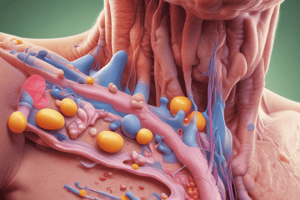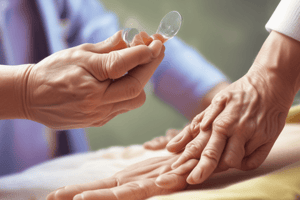Podcast
Questions and Answers
Which imaging study is typically used to assess joint damage in gout?
Which imaging study is typically used to assess joint damage in gout?
- CT scans
- X-rays (correct)
- MRI scans
- Ultrasound
What is the significance of monitoring kidney function in gout treatment?
What is the significance of monitoring kidney function in gout treatment?
- To prevent kidney stone formation
- To check for tophi formation
- To assess for potential medication side effects (correct)
- To evaluate the effectiveness of therapy
In which situation does gout management require particularly careful consideration due to drug interactions?
In which situation does gout management require particularly careful consideration due to drug interactions?
- In patients under 30 years old
- In populations with kidney disease (correct)
- In patients without comorbidities
- In individuals with normal kidney function
What are tophi in the context of gout?
What are tophi in the context of gout?
Which of the following is a secondary complication associated with hyperuricemia?
Which of the following is a secondary complication associated with hyperuricemia?
What is essential for effective management of gout in patients with concurrent conditions?
What is essential for effective management of gout in patients with concurrent conditions?
What aspect is crucial in the evaluation of treatment response during the acute phase of gout?
What aspect is crucial in the evaluation of treatment response during the acute phase of gout?
What is considered the first-line treatment for rapid symptom relief during an acute gout attack?
What is considered the first-line treatment for rapid symptom relief during an acute gout attack?
Which medication is NOT commonly used for urate-lowering therapy in chronic gout management?
Which medication is NOT commonly used for urate-lowering therapy in chronic gout management?
What role does patient education play in the management of gout?
What role does patient education play in the management of gout?
Which of the following statements correctly describes corticosteroids in the context of acute gout attacks?
Which of the following statements correctly describes corticosteroids in the context of acute gout attacks?
Which lifestyle modification is essential for chronic gout management?
Which lifestyle modification is essential for chronic gout management?
How often should serum uric acid levels be monitored to evaluate treatment efficacy for chronic gout?
How often should serum uric acid levels be monitored to evaluate treatment efficacy for chronic gout?
What is a major concern when prescribing colchicine for acute gout attacks?
What is a major concern when prescribing colchicine for acute gout attacks?
Which of the following is NOT a role of patient support in managing gout?
Which of the following is NOT a role of patient support in managing gout?
Flashcards
Imaging Studies for Gout
Imaging Studies for Gout
X-rays and other imaging techniques are used to assess the extent of joint damage caused by gout.
Evaluating Gout Treatment Response
Evaluating Gout Treatment Response
Evaluating how well treatment is working, especially in the initial stages, helps adjust the treatment plan.
Monitoring Side Effects of Gout Medications
Monitoring Side Effects of Gout Medications
Regularly monitoring for potential side effects of medications, especially kidney and liver function.
Gout in Special Populations
Gout in Special Populations
Signup and view all the flashcards
Tophi Formation
Tophi Formation
Signup and view all the flashcards
Kidney Complications of Gout
Kidney Complications of Gout
Signup and view all the flashcards
Concurrent Conditions Complicating Gout
Concurrent Conditions Complicating Gout
Signup and view all the flashcards
Acute gout attack management
Acute gout attack management
Signup and view all the flashcards
What are the main first-line treatments for acute gout attacks?
What are the main first-line treatments for acute gout attacks?
Signup and view all the flashcards
What is urate-lowering therapy (ULT)?
What is urate-lowering therapy (ULT)?
Signup and view all the flashcards
What are the most popular drugs used in ULT?
What are the most popular drugs used in ULT?
Signup and view all the flashcards
How do Probenecid and Sulfinpyrazone work?
How do Probenecid and Sulfinpyrazone work?
Signup and view all the flashcards
Why is regular testing of serum uric acid levels important?
Why is regular testing of serum uric acid levels important?
Signup and view all the flashcards
What is the importance of patient education and adherence?
What is the importance of patient education and adherence?
Signup and view all the flashcards
How are gout patients monitored and evaluated?
How are gout patients monitored and evaluated?
Signup and view all the flashcards
Study Notes
Acute Gout Attack Management
- Rapid symptom relief is crucial. NSAIDs are often the first-line treatment for acute gout attacks, providing significant pain relief.
- Colchicine is another option, though it has a narrower therapeutic window and potential side effects, especially gastrointestinal upset, and it may not be suitable for all patients or all conditions.
- Corticosteroids, either oral or intra-articular (injected directly into the affected joint), are powerful anti-inflammatory agents that can rapidly reduce inflammation and pain.
- Patient education about the management of the attack, including avoiding triggering factors, is an important aspect of treatment.
Chronic Gout Management
- Urate-lowering therapy (ULT) is crucial for preventing recurrent attacks and long-term complications of gout, such as tophi formation and joint damage.
- Allopurinol is a frequently prescribed ULT, inhibiting xanthine oxidase, the enzyme responsible for uric acid production.
- Febuxostat is an alternative ULT, acting on the same enzyme.
- Probenecid or sulfinpyrazone increase urate excretion, making them useful choices for patients who produce normal amounts of uric acid.
- Lifestyle modifications play an important role. A balanced diet and weight loss can help reduce uric acid production and excretion. Reducing alcohol consumption, especially of beer and spirits, and limiting foods high in purines (e.g., red meat, seafood) may also help.
- Regular monitoring of serum uric acid levels is necessary to adjust ULT therapy and assess treatment efficacy.
Patient Education and Adherence
- Patient education about the nature of gout, triggers, and treatment options is essential to ensure adherence to therapy.
- Clear communication between patients and healthcare providers is vital, ensuring realistic expectations and appropriate support.
- Addressing potential side effects and adverse reactions of medications is key, allowing patients to make informed decisions about optimal treatment choices.
- Lifestyle modifications should be tailored to individual needs and preferences. Patient support and tailored interventions can improve adherence.
Monitoring and Evaluation
- Regular monitoring of serum uric acid levels is key to evaluating treatment efficacy and adjusting ULTs as needed.
- Physical examination of affected joints should be performed.
- Imaging studies (e.g., X-rays) may be employed to assess joint damage and extent of the condition.
- Evaluation of response to treatment, particularly in the acute phase, helps refine the plan.
- Monitoring for potential side effects of medications (e.g., kidney function, liver function) is essential.
Special Considerations and Complications
- Gout in specific populations (e.g., those with kidney disease, other comorbidities) requires careful consideration of potential drug interactions and adverse effects.
- Tophi formation (deposits of urate crystals) is a long-term complication that can be surgically removed if appropriate.
- Kidney stones and renal impairment can occur as secondary complications associated with hyperuricemia.
- Concurrent conditions can complicate gout management. Close monitoring with a healthcare provider is necessary.
Studying That Suits You
Use AI to generate personalized quizzes and flashcards to suit your learning preferences.


